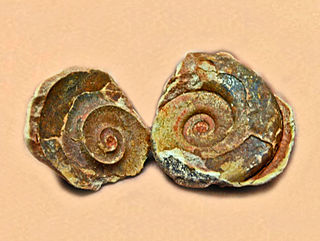Acanthinites is a genus of extinct cephalopods belonging to the ammonoid order Ceratitida described by Mojsisovics in 1893 who established the type species of the group as Acanthinites excelsus. The Shell is involute, compressed; sides arched, converging on narrow venter with a central furrow bordered by low serrated keels. Flanks are covered by numerous spiral rows of tubercles.

Acrochordiceras is a genus of Middle Triassic ammonoid cephalopods belonging to the ceratitid family Acrochordiceratidae, included in the superfamily Ceratitoidea.
Anatropites is a genus of ammonite in the ceratitid family Tropitidae with spines instead of nodes on the umbilical shoulder, at least in early whorls. Ceratitids are mostly Triassic ammonoid cephalopods.

Arcestes is a genus of extinct ceratitid ammonites found in Triassic-aged marine strata.

Arctoceras is a genus of ceratitid ammonoids from the Lower Triassic with a moderately narrow discoidal shell and ceratitic suture.
Ussuria is a genus of Lower Triassic ammonites with a smooth, involute discoidal shell with submonophyllic sutures, belonging to the ceratitid family Ussuriidae.

Xenodiscoidea, formerly Xenodiscaceae, is a superfamily within the ammonoid order Ceratitida. The superfamily was named by Frech in 1902, presently contains ten families, only one of which was included in the original Otocerataceae of Hyatt, 1900, the remaining having been added.
The Ophiceratidae is a family in the ammonoid order Ceratitida from the Lower Triassic, previously included in the Otocerataceae but now placed in the Noritiaceae as revised.
Clydonitoidea, formerly Clydonitaceae, is a superfamily in the ammonoid cephalopod order Ceratitida characterized by generally costate and tuberculate shells with smooth, grooved, or keeled venters and sutures that are commonly ceratitic or ammonitic but goniatitic in a few offshoots.

The Trachyceratidae is an extinct family of ceratitid ammonoid cephalopods.

Gymnitidae is a family of Lower to Middle Triassic ammonite cephalopods with evolute, discoidal shells.
Mesohedenstroemia is a genus of ammonites. It was described by Chao in 1959, who described three species; M. kwangsiana, M. inflata Chao, 1959, and M. planata, from the Triassic of what is now China. A new species, M. olgae, was described from the Olenekian of Russia by Yuri D. Zakharov and Nasrin Mousavi Abnavi in 2012, and was named in honour of Olga P. Smyshyaeva.

Mantelliceras is an extinct ammonoid cephalopod genus belonging to the family Acanthoceratidae and type for the subfamily Mantelliceratinae, that lived from the Late Albian to the late Cenomanian stage of the Late Cretaceous.
Dieneria is a genus of ceratitid ammonoid cephalopods from the Late Triassic of western North America with a smooth discoidal shall of which the venter is truncate and the suture simple. Only the first lateral lobe is slightly serrated, the other lobes entire (smooth)

Meekoceras is an extinct genus of ceratitid ammonites with a discoidal shell that lived during the Early Triassic Epoch.
Clypeoceras is a genus of ammonites with an involute discoidal shell from the Lower Triassic.
Sturia is a genus of ceratitid ammonoids from the Lower Triassic with an ammonitic suture.
Eophyllites is a genus of ammonoid cephalopods from the Lower Triassic and a predecessor of genera like Monophyllites and Ussurites.
Neocardioceras is a genus of evolute acanthoceratid ammonites from the uppermost Cenomanian, Upper Cretaceous, of Europe, western U.S. and Brazil.
Binneyitidae is a family of Upper Cretaceous ammonoid cephalopods characterized by rather small, compressed, flat sided shells and sutures that tend to have deep, narrow, simple elements with parallel sides, that range from the upper Cenomanian into the lower Santonian.







